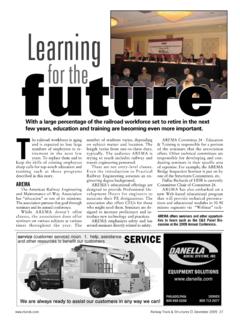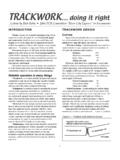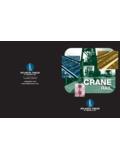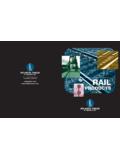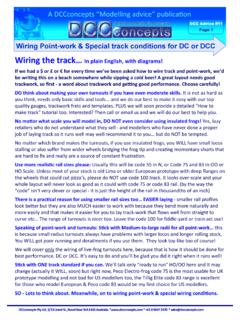Transcription of Rail track and associated equipment for use …
1 Health and Safety Executive rail track and associated equipment for use underground in mines Guidance on selection, installation and maintenance Contents Status of document 3 Introduction 4 Some basic principles 4 What the guidance covers 4 Who the guidance is for 4 The legal framework 4 Components of rail track 5 Rails 5 Fishplates and fishbolts 7 Alternatives to fishplates and fishbolts 9 Sleepers 9 rail fastenings 11 Ballast 14 Special track for steep gradients 15 Curved track 18 Flange climbing 18 Radius of curves 19 Super elevation (cant) 23 Check rails on curves 26 Gauge widening on curves 27 Gauge ties 28 Gradual transitions into curves 28 Reverse curves 30 Clearances on curves 31 Turnouts and crossings 35 Switches 36 Crossings 40 Geometry of a turnout 42 Check rails on crossings 45 Stretcher bars and connecting rods 47 Lever boxes 48 Remote operation of switch blades 52 Clamp locking mechanisms 52 Switch blade monitoring 54 Non standard turnouts 55 track installation and maintenance 57 track standards 57 track specification 57 Preparing the roadway floor 57 Health and Safety Executive Installing straight track 58 Additional requirements for installing curves 64 Installing turnouts and crossings 65 Statutory requirements 67 Commissioning 67 Planned preventive maintenance 67 Tolerance
2 Limits for installation and maintenance 70 Installation and maintenance standards for captive rail track 71 Checking roadway clearances 73 Safety during trackwork 74 Risk assessment 74 Safe systems of work 74 Pedestrian safety 75 Lifting and handling hazards 76 Vehicle arrestors 77 Prevention and control of runaways 77 Retarders 77 Types of retarder 78 Appendix: Legislation relevant to this guidance 82 References 83 Further information 84 rail track and associated equipment for use underground in mines 2 of 84 pages Health and Safety Executive Status of document This guidance was prepared by the Health and Safety Executive (HSE). It has been agreed by the Mining Industry Committee. Following the guidance is not compulsory and you are free to take other action. If you do follow this guidance you will normally be doing enough to comply with the law.
3 Health and safety inspectors seek to secure compliance with the law and may refer to this guidance as illustrating good practice. rail track and associated equipment for use underground in mines 3 of 84 pages Health and Safety Executive Introduction Some basic principles 1 Good rail track standards are fundamental to the safe and efficient operation of rail transport systems underground in mines. 2 The design and layout of rail track needs to be incorporated into the overall planning of the mine to ensure that practical payloads and acceptable journey times are achievable. In particular, the mine roadways should be designed to have adequate clearances, suitable gradients and the largest practical radii on curves. 3 Careful selection of rail track components, the use of competent tracklayers and installing the track to a suitable specification will enhance safety and significantly reduce future maintenance needs.
4 What the guidance covers 4 This guidance covers rail track used underground in mines by locomotive and rope haulage systems, to transport people, equipment , material supplies and minerals. It does not apply to temporary trackwork, or to light duty trackwork used solely for mineral or material transport at speeds below 5 km/hour. However, for these systems a suitable risk assessment should be performed to ensure that the standards and control measures adopted are appropriate for the hazards. 5 This guidance gives technical advice on the selection of rail track components, recommends standards for installation and maintenance and gives background information on the design of turnouts and curves. The guidance principally deals with conventional rail track , including high speed (16 km/hour and over) track and, where appropriate, makes specific reference to captive rail track , rack locomotive track and rope hauled systems.
5 It also gives advice on the safety of track workers and on track mounted vehicle retarders. Who the guidance is for 6 This guidance is aimed at engineers, technicians and purpose trained personnel who have duties to select, install, maintain, inspect and deal with trackwork at mines. It is not intended to provide guidance for manufacturers of rail track . 7 The guidance is relevant to underground rail track in coal mines, miscellaneous mines and tourist mines. 8 The guidance may be of use to other sectors outside the mining industry that use narrow gauge rail track , such as the tunnelling sector and narrow gauge railway operators. The legal framework 9 The principal legislation associated with the selection, installation and maintenance of rail track and associated equipment for use underground in mines is listed in the Appendix.
6 rail track and associated equipment for use underground in mines 4 of 84 pages Health and Safety Executive Components of rail track 10 rail track not only supports the train weight, it also resists the longitudinal forces resulting from tractive and braking effort and the lateral forces resulting from guiding the wheels. Those designing and maintaining track should therefore select and use only those components that are suitable for the proposed duty and fit for purpose. Rails Determining the correct rail size 11 Rails are described and specified by their weight per unit length. The minimum weight per metre of rail required depends on the maximum axle load of the heaviest vehicle that will run on the track and the quality of vehicle suspension. Without sprung suspension even minor changes in track cross level will cause full axle loads to be carried on one wheel.
7 For locomotive systems, the minimum weight of rail allowable is specified in 12 However, dutyholders should take note that when selecting heavier duty rail than the minimum required, there will be a significant reduction in maintenance costs and improved running qualities. 13 Generally, steel tyred locomotives have been designed around a maximum axle load of tonnes. To contend with modern demands for heavier loads and heavier locomotives, yet retain the maximum axle loading within the tonnes, multiple axle wheel sets have been used. Rubber tyred locomotives are designed with much lower axle loads than this to avoid undue compression of tyres. 14 When axle loads occasionally exceed those for which the track is designed, special arrangements should be made to ensure that the transport is carried out safely, eg by reducing speeds and improving track maintenance.
8 Sleeper spacing 15 The method of selecting rail size according to axle loading assumes that suitable sleeper spacing is specified and used. Increasing the sleeper spacing beyond that specified in paragraph 232 will significantly reduce the margin of safety against rail failure. Minimum rail size 16 The minimum weight of rail recommended for any new installation underground in mines is kg/m (35 lb/yd). Provided that sleepers are suitably spaced and properly ballasted, this size of rail gives a good general purpose track in a typical mining environment. Common rail sizes 17 The three sizes of rail most commonly used are kg/m (35 lb/yd), kg/m (50 lb/yd), and kg/m (60 lb/yd). Figure 1 shows the principal dimensions for each rail size. The rail sections are referred to by section numbers in British Standards and the designations are BS 2482 35M(FB), where M is for mining and FB is for flat bottom, BS 113 50 O and BS 11 60 A ( O and A are alphabetic designations), usually abbreviated to 35M, 50, and 60A.
9 rail track and associated equipment for use underground in mines 5 of 84 pages Health and Safety Executive 435276(a) kg/m(35 lb/yd)BS 24835 Mfishingangle100(b) kg/m(50 lb/yd)BS 115057110(c) kg/m(60 lb/yd)BS 1160A2227251 in 2081100114fishinganglefishingangleFigure 1 Common rail sizes and principal dimensions 18 The length of rails used in mines varies from 3 m to 7 m. The size chosen at a particular mine often depends on the limitations imposed by the shaft and transport arrangements. The aim should be to select the longest length of rail , which reduces the number of joints needed when it is installed. This will also result in a reduction in supply and maintenance costs. Note that rail steel has a medium to high carbon content and careless heating and cooling can produce material defects.
10 For this reason, flame cutting of rails should be avoided. rail welding should only be performed by people with specialist knowledge. Construction of electric trolley locomotive track 19 When selecting components for electric trolley locomotive track , consideration needs to be given to electrical conductivity, earthing of rail track and bonding of rail joints. Additional information can be found in Guidance Note 2 of the Approved Code of Practice accompanying the Electricity at Work Regulations 1989, The use of electricity in mines rail track and associated equipment for use underground in mines 6 of 84 pages Health and Safety Executive Fishplates and fishbolts Fishplates 20 Fishplating is the most common method of joining rails used in underground rail track . For maximum joint rigidity, fishplates need to be fixed by at least four bolts.










